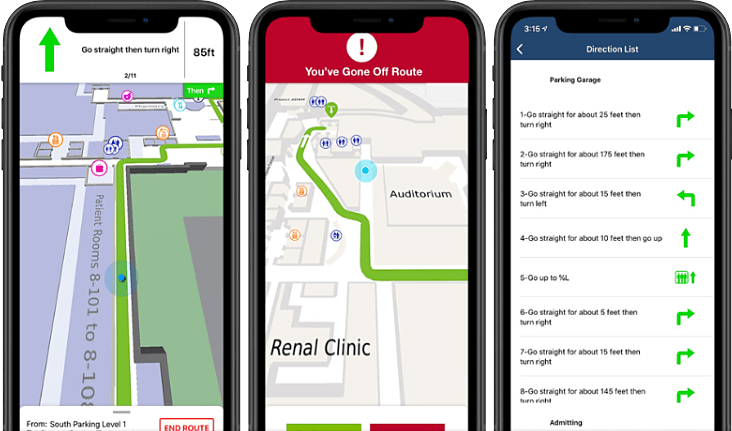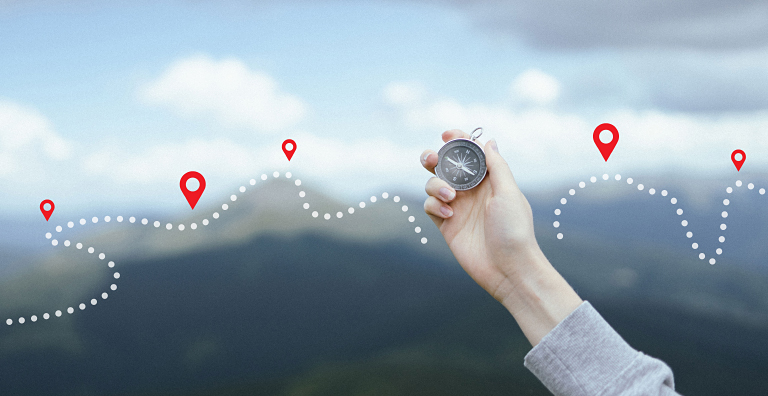Wayfinding – Indoor Positioning System for Navigating Large Campuses
Missed or late appointments cost hospitals time and money.
For Emory University Hospital, that cost amounted to more than $400,000 in 2021.
Patient journeys — the process of navigating through a hospital’s physical system from parking to office visit to tests (such as X-rays) — are an important consideration when it comes to patient satisfaction. Leakage, where patients go to another facility either mistakenly or intentionally, has a negative impact on patient satisfaction and is an essential issue for healthcare systems to address.
Improving how people get around a large sprawling campus like a hospital (or a university) is called wayfinding — it is the process or activity of ascertaining one's position, then planning and following a route.
Just as GPS navigation has changed how we get from one place to another outdoors, new and innovative indoor positioning systems are changing how we get around inside and offer a lot more than just directions — including ROI for organizations.
Wayfinding benefits and solutions to organizational challenges include:
- Customized flows to avoid potential bottlenecks
- Support of social-distancing policies
- Less reliance on staff to provide directions
How a Digital Wayfinding System Works With an IoT Network
The goal of a good wayfinding system design should always be to aid the user in spatially orienting themselves so they can easily navigate to a specific location. An Indoor Positioning System (IPS) is a solution specifically designed to do that.
An IPS might leverage a campus’ IoT network when used in conjunction with Bluetooth® Low Energy readers, sensors and gateways strategically placed throughout a sprawling campus, such as a hospital.

Thanks to RFID technology and Real-Time Location Systems (RTLS) coupled with an IPS, the result is a user friendly step-by-step, turn-by-turn mapping of where to go from the parking lot to the appointment and back again — all with a digital touch of a button.
Users can simply interact with the system via a downloadable application (iOS or Android) on their mobile device.
Kiosks, like you would see in an indoor mall, can also display location and direction information to help visitors find their way in lieu of using a mobile app.
Navigation With HID’s Indoor Positioning System Powered by RTLS
HID recently acquired Connexient (part of Everbridge) to provide customers with an innovative turnkey wayfinding solution. This is a digital mapping and navigation product designed to help people navigate their way around a complex campus environment with ease and reliability.
Proper installation of the RTLS infrastructure, coupled with the mobile app on a visitor’s compatible smartphone, allows visitors to get around a large indoor campus as if they are there every day.
Visitors using this solution report a much-improved experience navigating.
From parking to alerts, this solution provides a unique and robust digital wayfinding system that visitors have come to rely on.
In the case of a healthcare environment, the patient parks at a pre-designated conveniently located garage. Their vehicle’s location is saved so they won’t have any trouble finding it after their visit.
Opening the app registers the patient’s car location and provides step-by-step instructions and a map that updates as they travel to their on-campus destination. The map updates in real-time, just like GPS, offering a familiar experience similar to using Apple Maps or Google Maps in walking mode.
If patients are meeting others during their visit and those individuals are running the same digital wayfinding app, they can easily coordinate their meetups.
Patient safety is also a paramount concern. If a crisis happens, a visitor’s wayfinding-enabled smartphone can alert them of it. Both the nature of the crisis (e.g., a fire) and evacuation instructions are delivered.
And finally, upon departure, the patient will be able to easily find their vehicle, and if EFT or NFC payment is enabled, payment for parking can be made automatically. All the patient has to do is tap their smartphone to the reader at the outgoing boom barrier’s kiosk and away they go.

Having a digital navigator wayfinding solution has the potential to save an organization money and provide ROI in a number of ways:
- It’s used by everyone from patients/visitors, HVAC techs, staff and more
- Well-designed wayfinding saves money (mentioned above)
- Wayfinding builds team cohesion when co-designed by cross-staff teams
- Well-designed wayfinding solves problems before they happen (mentioned above)
- It’s simply the right thing to do to improve the patient/visitor/staff experience
With a valuation expected to reach $665 million US by 2028, wayfinding is a growth market for both system integrators who build out these networks and organizations who deploy them.
The digital wayfinding solutions market is projected to reach US$ 665.0 million by 2028 from US$ 234.6 million in 2021; it is expected to grow at a CAGR of 16.0% from 2021 to 2028. Global Digital Wayfinding Solutions Market Forecast to 2028 - COVID-19 Impact and Global Analysis by Component, Deployment, Application
Getting there from here, digitally, is a staple of modern life. Handheld navigation technology, and wearable navigation devices (e.g., the Apple Watch, Garmin Fēnix Watch, the Samsung Galaxy Watch, etc.) are all but built into people these days. Therefore, why not leverage this lifestyle trend — from a lucrative market — while helping patients, students or visitors get around a labyrinthine site like they live there?
For a deeper dive into how HID Global’s RTLS offers a wealth of solutions for large-scale organizations such as health care facilities, visit our RTLS in Healthcare page.
Nick Iandolo is an experienced Senior Editor Marketing Strategist specializing in Content Marketing and Corporate Communications Writing, primarily for market-disrupting technology organizations. His work has been featured in publications such as Morning Consult, NewDesign Magazine UK, SmartCard Identity News, and Construction Outlook. Nick is also a Spartan Race athlete, and lives just outside of Boston Mass with his wife, daughter, and Golden Retriever.
